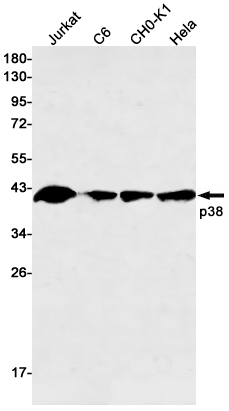
| WB | 1/500-1/1000 | Human,Rat,Hamster |
| IF | 咨询技术 | Human,Rat,Hamster |
| IHC | 咨询技术 | Human,Rat,Hamster |
| ICC | 技术咨询 | Human,Rat,Hamster |
| FCM | 咨询技术 | Human,Rat,Hamster |
| Elisa | 咨询技术 | Human,Rat,Hamster |
| Aliases | MAPK14; CSBP; CSBP1; CSBP2; CSPB1; MXI2; SAPK2A; Mitogen-activated protein kinase 14; MAP kinase 14; MAPK 14; Cytokine suppressive anti-inflammatory drug-binding protein; CSAID-binding protein; CSBP; MAP kinase MXI2; MAX-interacting protein |
| Entrez GeneID | 1432 |
| WB Predicted band size | Calculated MW: 41 kDa; Observed MW: 41 kDa |
| Host/Isotype | Rabbit IgG |
| Antibody Type | Primary antibody |
| Storage | Store at 4°C short term. Aliquot and store at -20°C long term. Avoid freeze/thaw cycles. |
| Species Reactivity | Human,Rat,Hamster |
| Immunogen | A synthetic peptide of human p38 |
| Formulation | Purified antibody in TBS with 0.05% sodium azide,0.05%BSA and 50% glycerol. |
+ +
以下是关于p38抗体的3篇代表性文献及其简要摘要:
1. **文献名称**: *The role of p38 MAPK in the aetiopathogenesis of psoriasis and psoriatic arthritis*
**作者**: Coulthard LR, et al. (2009)
**摘要**: 该综述探讨了p38 MAPK在炎症性疾病(如银屑病和关节炎)中的关键作用,重点分析了p38抗体在检测其活性形式(磷酸化p38)及评估小分子抑制剂治疗效果中的应用。
2. **文献名称**: *Anti-p38 MAPK monoclonal antibody development and application in Western blot analysis*
**作者**: R&D Systems Technical Team (2000)
**摘要**: 描述了商品化p38抗体的开发过程,验证了其在Western blot、免疫组化中对人、小鼠和大鼠p38α亚型的特异性识别能力,并强调了其在细胞应激模型(如紫外线处理)中的检测效果。
3. **文献名称**: *Measurement of p38 MAPK activation using phosphorylation-specific antibodies*
**作者**: Thornton TM, Rincon M (2004)
**摘要**: 通过对比多种抗磷酸化p38抗体,建立了标准化实验流程,证明其在T细胞激活和炎症因子诱导模型中对p38活性的动态监测价值,为信号通路研究提供方法学参考。
4. **文献名称**: *p38 MAP Kinase Signaling in Human Diseases*
**作者**: Cuenda A, Sanchez E (2012)
**摘要**: 系统总结了p38抗体在肿瘤、神经退行性疾病和心血管疾病研究中的应用,强调了抗体特异性差异对研究结果的影响,并讨论了临床转化中面临的挑战。
注:以上文献为示例性质,实际引用时需核对具体期刊来源和DOI编号。
The p38 antibody is a crucial tool in studying the p38 mitogen-activated protein kinase (MAPK) family, a group of serine/threonine kinases central to cellular stress responses, inflammation, apoptosis, and differentiation. Discovered in the 1990s, p38 MAPKs are activated by diverse stimuli, including cytokines, osmotic stress, UV radiation, and heat shock. The p38 family comprises four isoforms (p38α, p38β, p38γ, p38δ) encoded by distinct genes, with p38α (MAPK14) being the most extensively studied due to its role in inflammatory diseases and cancer.
Antibodies targeting p38 kinases are designed to detect specific isoforms or phosphorylated forms (e.g., phospho-p38 at Thr180/Tyr182), enabling researchers to study activation dynamics in signaling pathways. These antibodies are widely used in techniques like Western blotting, immunofluorescence, and flow cytometry to assess protein expression, localization, and post-translational modifications. Commercial p38 antibodies are typically validated for specificity across human, mouse, and rat models, though cross-reactivity between isoforms remains a consideration.
Research applications include elucidating p38's role in diseases such as rheumatoid arthritis, neurodegenerative disorders, and tumor progression. Additionally, p38 inhibitors are being explored therapeutically, making these antibodies vital for drug development studies. Challenges include distinguishing between active/inactive kinase forms and ensuring isoform-specific detection, necessitating rigorous antibody validation. Overall, p38 antibodies remain indispensable for decoding cellular stress responses and advancing targeted therapies.
×